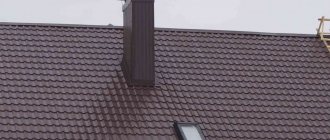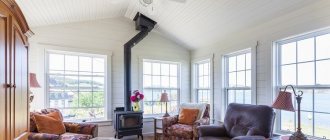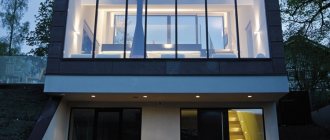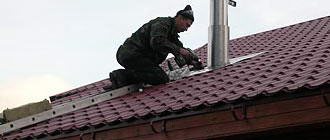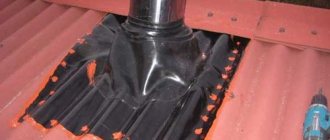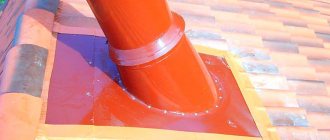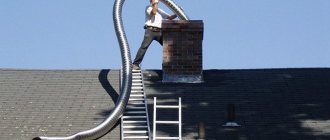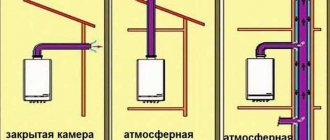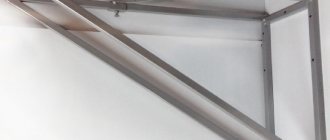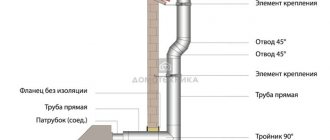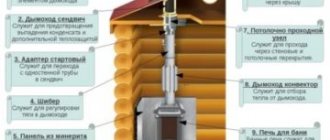Andrey
5753 0 0
Andrey November 1, 2017 Specialization: facade finishing, interior finishing, construction of dachas, garages. Experience of an amateur gardener and gardener. We also have experience in repairing cars and motorcycles. Hobbies: playing the guitar and many other things that I don’t have time for :)
The chimney on the roof is a critical and rather complex element of the smoke exhaust system of heating devices. Therefore, its design raises a number of questions for beginners, in particular, many people are interested in how to make the structure fireproof, efficient, and at the same time tightly adjacent to the roof. Next, I will try to answer these and other popular questions, and also share with you the important nuances of chimney installation.
The chimney must be reliable and fireproof
Chimney installation rules
If the house has a stove, then a chimney is also needed. Although instead of a stove there may be a special tank running on gas. In any case, the house is heated somehow, and combustion products need to be removed. There are several options for removing the pipe through the roof, related to determining the location. It is planned when a house project is being developed. The location is considered relative to the ridge of the roof - a horizontal edge that is located where two slopes meet. The pipe can be installed:
- directly in the ridge;
- at a distance from the ridge.
The first and second options have their pros and cons. On the one hand, it is easier to install a chimney in a ridge. But this is for someone who deals with this particular issue. But for arranging a rafter system, this is more difficult, because you will have to make a gap in the horizontal beam. On the other hand, when the pipe is in the ridge, this guarantees good traction. And the possibility of leakage under it is reduced to a minimum here. But still, most often the chimney is moved relative to the ridge.
Chimney offset relative to the roof ridge Source katlavan.ru
In this case, the following building regulations must be observed:
- If the chimney on the roof is installed at a distance of no more than 1.5 m from the ridge, then the pipe should be 0.5 m higher than it.
- When installed at a distance of 1.5 m to 3 m from the ridge, it is made on the same level with it.
- When the pipe is more than 3 m from the ridge, it can be lower than it, but no more than 10°.
The best option for locating the pipe relative to the ridge is not far from it. If you make the chimney much lower, the risk of damage from falling snow increases.
To ensure good traction, you must adhere to certain standards for placing the chimney relative to the roof ridge Source rekvartira.ru
There is a place where it is generally not recommended to install a pipe - the valley. This is the internal angle that two slopes of a complex roof form when connected. There is always an increased load on it, since precipitation flows there and snow is retained. With such an installation, the possibility of waterproofing damage is very high. This means that there will be leaks.
Independent design and assembly of chimneys
The chimney provides an influx of fresh air and removes combustion products from the room, and is responsible for the natural draft of a stove or gas boiler. Installation of a chimney is a prerequisite for the operation of heating equipment.
DIY chimney
Correct installation of a chimney is the key to a comfortable microclimate and safety inside a house, cottage or bathhouse. To save money, you can assemble the chimney yourself. It is important to correctly calculate and comply with all existing standards for the design and installation of chimneys.
Related article: Mastic for garage roof repair
Protecting the roof from heat coming from the pipe
When organizing a pipe passage through the roof, it is important to insulate the roof from it. After all, the pipe gets very hot, which increases the fire hazard. The roof is protected using a separate box, the beams and rafters of which are located taking into account the requirements of SNiP. The minimum distance standard from the chimney to the load-bearing beams and rafters is from 130 to 250 mm. The inside of the box is filled with some material that does not burn. For example, it could be basalt or stone wool.
The chimney in no case directly touches the roofing Source barmanlive.ru
Further organization of the pipe outlet depends on what shape it is and what it is made of. The shape of the chimney can be made either as a regular square or round, or in the form of a rectangle or oval. And pipes can be brick, metal, asbestos-cement or ceramic. The material from which the roof is made is also taken into account. This can be slate, metal tiles, corrugated sheets, ondulin, roofing felt or bitumen shingles. Each case has its own characteristics.
Sealing a pipe on the roof
Sealing of the chimney on the roof is carried out taking into account the shape of the pipe and the relief of the roof covering:
- For rectangular and square designs, a metal apron is suitable;
- For round outlets, elastic rubber or polymer penetrations are often used;
- Sandwich-type pipes are equipped with a metal cone fixed at an angle to a steel apron;
- Slate or metal tiles are equipped with lead abutment strips or the Master Flash system.
Installing a pipe on a metal roof
Places where pipes pass through the roof
There is a pattern - the lower the pipe is placed along the roof slope, the more effort will be required to waterproof the joint between the chimney and the roof.
Roofs made from corrugated sheets are equipped with pipes in the following areas:
- Near the skate. According to SNiP 41-01-2003, the installation of the device near the ridge will reduce the likelihood of the formation of snow pockets and the appearance of condensation.
- Insulation of the chimney on the slope. The passage of the chimney is at a distance of 500-700 mm. from the roof ridge reduces the risk of leakage and preserves the rafter structure. Elastic penetrations or additional apron elements will help protect the joint.
Structural elements of the junction of the roof and the chimney
When planning to make a chimney passage through the roof with your own hands, start with a wooden box.
- Select bars that match the thickness of the floor beams (minimum 5-10 cm), and measure a length that increases the size of the pipe by 15-25 cm.
- Connect the boards to form a square or rectangular structure (corresponding to the shape of the chimney), attach to the horizontal and vertical floor beams.
- Prepare additional materials: upper and lower aprons, tie (a long smooth sheet with a flange to drain rainwater), sealant.
- The abutment strips that form the apron are installed on the sides, top and bottom. An internal flashing is placed under the roofing material to drain water. A tie with a length equal to the distance of the lower apron to the cornice is placed under it. External junction strips perform decorative functions and prevent moisture from entering the area where the chimney passes through the roof.
- Basalt wool will help close the hole around the pipe and floor beams. The distance between the concrete and brick chimney, relative to the elements of the rafter system, is 13 cm; a gap of 25 cm is left from the ceramic uninsulated pipe; if there is a heat-insulating layer, 13 cm.
- The gap between the pipe and the combustible material is covered with sheet metal. The tightness of the roof is ensured by a special film, which is cut through with an envelope and the edges are fixed on the outer part of the pipe or wooden box.
When organizing the output of a round pipe, it is enough to select an elastic seal, eliminating the need for additional waterproofing protection around the penetration.
Skate cutting
A smooth metal apron and a decorative seal made of slate or corrugated board will allow water to be drained away from the smoke system passing through the ridge.
- Lay a tin sheet (tie) near the pipe, placed under the roofing.
- Fix the bottom, then the side and top abutment strips.
- Fill the joints near the pipe with silicone-based sealant.
- Press with the top strips of the apron.
Drainage of rainwater from the chimney
Walking on the ramp
When constructing a small penetration, fix the drainage gutter on the roof slope.
Cutting for pipes with a width of more than 80 cm will require the creation of a slope on the roof slope to drain water coming from above to the center of the chimney.
Two short valleys (grooves) are formed on top. The lower valley strip is installed at the joints of negative angles, protecting against water entering the under-roof space. It is placed before laying the corrugated sheets. The top bar performs purely decorative functions.
Installing a round chimney will require additional costs, since its proper organization requires additional components
Bypassing the rafter system
A high-quality connection of the roof to the chimney pipe is possible with a rigid sheathing, which allows the load to be evenly distributed. The chimney is usually installed before the rafter system is strengthened.
If the withdrawal is carried out later, it is important to provide a distance from the rafters of more than 20 cm, otherwise it will be necessary to dismantle the sheathing, weakening the overall system.
Chimney sheathing
- Install support posts under the elements of the rafter frame, cut off the ceilings and connect them to the entire rafters using horizontal jumpers.
- Build a reliable frame around the smoke outlet, firmly connected to the rafter system and roof sheathing.
Installation of a round pipe
Often in construction a circular chimney section is used. To pass a round pipe through the roof and seal it tightly, special flexible adapters are used. They are made from heat-resistant polymer with elastic properties. In appearance, such an adapter looks like a funnel, at the base of which there can be a circle or a square. The base is called an apron, it is made in the form of wide fields. Since the material is elastic, it easily takes on different configurations. Therefore it has a wide range of applications. Such adapters can be used on roofs with any covering and slope angle.
Exit of a round pipe through an ondulin roof Source nashaotdelka.ru
The main thing is to choose an adapter that will match the diameter of the pipe. Although there are universal options for such products. They are made in the form of a stepped pyramid. To adjust their size to the pipe, the excess is simply cut off with scissors. Elastic adapters are attached to the roof using bolts or metal studs. They are installed in holes on the flange, which presses the adapter to the roof. The space between the flange and the roof surface is lubricated with a sealant that can withstand temperature changes.
Universal adapter for passing a round pipe through the roof Source pinterest.it
Choosing a sealant for chimneys
There are two types of sealant for installing chimneys:
Heat-resistant compounds are usually used to insulate the outer surfaces of stoves and fireplaces, as well as to insulate joints between brick pipes and roofing. It can also be used when installing sandwich pipes, but not made of metal.
Many sealants are based on silicone, with the addition of iron oxide, due to which such sealant is able to withstand constant temperatures from 250 to 350 degrees. Heat-resistant sealants can be acidic or neutral.
Heat-resistant compounds are used in cases where the constant heating temperature ranges from 1200–1300 degrees, and short-term heating reaches 1600 degrees. This sealant is used to seal cracks in stove fireboxes where there is an open fire and to seal chimneys on the roof. For cases with open fire, you need to choose fire-resistant compounds.
Heat-resistant pastes contain silicate. During polymerization, it is converted into an organosilicon compound that is extremely durable and 100% waterproof.
Features of a sandwich chimney
A type of round pipe is a sandwich chimney. It consists of two pipes of different diameters, between which there is a heat-resistant thermal insulation material. They are made of stainless steel. The sandwich chimney is in great demand because it provides stable draft, does not heat up, is easy to install and looks beautiful in appearance.
The passage through the roof of a sandwich chimney can also be done using an elastic adapter. However, it may not be in harmony with its mirror surface. In this case, a metal adapter is used, the material of which is also stainless steel. It is not flexible, so you must take into account the diameter of the pipe and the angle of the roof slope.
Types of chimney structures
The chimney pipe serves to remove smoke and combustion products into the atmosphere. It is a hollow cylinder.
To organize this process, stove makers build:
- Brick chimneys . The smoke exhaust system is created from heat-resistant bricks, which are produced using a special technology specifically for the installation of stoves. The pipe has a rectangular or square cross-section. This method of getting rid of smoke is expensive, but it is more durable and safe. Its main disadvantage is the porous inner surface - for this reason, large amounts of soot and dust settle on it. If the pipe is not regularly cleaned, layers of soot can completely or partially clog it, reducing draft force and increasing the risk of fire. The process of how to remove a chimney through a roof from corrugated sheets is complex and therefore it is better not to do this work with your own hands - it should be done by experienced stove-makers.
- Metal chimney systems . To assemble a structure of the required configuration, you need to purchase stainless steel pipes with the addition of zinc or molybdenum. Then insert the segments into one another - you will need straight pipe products, clamps and elbows. Thanks to the presence of a slippery inner surface, soot cannot accumulate, which means that smoke can freely move upward, outside the house. The disadvantage of this method is that metal does not retain heat well enough compared to brick, as a result of which condensation collects on it, since there is a temperature difference between the pipe and the air outside. The metal chimney structure can be easily brought to the roof, because it consists of separate elements.
Passage through metal tiles
Metal tiles are sheets of steel, copper or aluminum, which are coated with a polymer layer. In appearance they resemble natural tiles, which are folded in even rows. This roofing material is very popular. If a round pipe is to be passed through the metal tile, flexible adapters are used, which we have already described. When using a square or rectangular brick pipe, a different method of installation is used. It is as follows:
- The connecting unit is being manufactured. It consists of two aprons - internal (main) and external (decorative). The material of manufacture is thin aluminum sheet or tin.
- Before the metal tiles are laid, an internal apron is installed on the sheathing. These are 4 strips located on 4 sides of the pipe. They simultaneously extend under the metal tile (no less than 250 mm) and onto the pipe (no less than 150 mm).
- The apron elements are installed in a groove - a groove that is cut along the perimeter of the pipe to a depth of 10 to 15 mm. The groove is cleaned and filled with fire-resistant sealant.
To install an apron, you need to make a special groove in the pipe Source experttrub.ru
- The apron is attached to the pipe using heat-resistant dowels. The joints between the four planks are soldered. On the slats that are located on the sides, sides are made, the purpose of which is to drain water down.
- The lower part of the apron is installed on the so-called tie - a sheet of metal with sides. This ensures water drainage from the chimney to the bottom of the roof. The width of the tie should be greater than that of the pipe by at least 0.5 m on both sides. Its length depends on the distance from the pipe to the edge of the roof.
- After installing the tie and interior apron, the metal tiles are laid.
- An external apron is installed on top. It is usually a corrugated sheet of lead or aluminum. There is a decorative strip in its upper part. It is attached to the pipe using self-tapping screws. The attachment point is slightly higher than parts of the inner apron. Before fixing the decorative strips, the fastening points are coated with sealant. To attach the corrugated sheet, its back side is provided with a self-adhesive coating.
Finished chimney pipe passed through a metal tile Source tproekt.com
Parameters for proper operation of the device
A properly installed chimney creates natural draft and removes combustion products through a channel, preventing them from entering the room. Sometimes you can even evaluate the operation of a chimney visually - by the presence of smoke in the room or the color of the flame. Excessive draft is determined by a white flame and a characteristic hum, while a bright orange flame indicates insufficient draft. A special device, an anemometer, will help you take more accurate measurements.
Related article: Laying OSB on the roof
If traction needs to be strengthened, you can use one of the following methods:
- Install the deflector. However, it must be taken into account that deflectors improve traction only in the presence of strong wind.
- Install a special umbrella on the chimney. Using a sensor located under the hood, the umbrella regulates the combustion temperature.
- Increase the height of the pipe.
- Use a turbine nozzle.
Installing a chimney through corrugated sheeting
Corrugated sheeting is a sheet of metal produced by cold rolling and then profiled. Mainly made of steel, but can be made of copper and aluminum. The sheet has ribs of oval, square, trapezoidal or polygonal shape. A special coating is made on top, which gives it anti-corrosion properties. Corrugated sheeting is often used as a roofing material.
To pass the chimney through the roof, in the case of a square or rectangular pipe, a device in the form of two aprons and a tie is used. The method is the same as for a metal roof. Installing round pipes in corrugated sheeting is not recommended, because it is difficult to cut the correct circular section into it. But if you still make a round chimney, the pipe is insulated using a universal elastic adapter.
Accessories for running round pipes Source metalsteel.com.pl
How to cut a hole
Once the location of the pipe has been determined, you need to mark and prepare a hole in the metal tile.
The coating layer, along with the heat and waterproofing, can be cut using a sharp knife or large scissors. There are two ways to make a hole in a metal tile:
- The hole can be made during installation or after the covering has been laid. To prepare a round and rectangular hole, use metal scissors, a jigsaw or nibblers.
- To prepare a hole with a circular cross-section, you need to draw a circle with several intersecting diameters in the center. After that, using metal scissors, you need to make cuts starting from the center of the markings to the edges, then bend the resulting triangles inward.
Passage through ondulin
Ondulin looks like regular slate, but its material is completely different. This is compressed cellulose, which is treated with bitumen impregnation. It comes in a variety of colors, is water resistant, but burns quite well. Therefore, when a passage through the roof is organized, maximum attention is paid to filling it with fire-resistant materials. The hole for the pipe in the ondulin is made large. To insulate the junction of the roof and the chimney, an apron is used, which is placed under the roof. In this case, elastic self-adhesive tape “Onduflesh” is used, made of bitumen with an aluminum insert.
Brick pipe passed through ondulin Source seaside-home.ru
kak.hepcinatvp.ru
07/19/2019 admin Comments No comments
A chimney on the roof of a house affects the fire safety of the building, the efficiency of the home’s heating system, and even the aesthetics of the exterior design. After all, this element of the chimney system affects the draft in the air duct, the tightness of the roof, and the contours of the facade of the house. In this article we will tell our readers how to bring a pipe through the roof without disturbing the tightness of the roof, free air exchange in the chimney, or the aesthetics of the facade.
Installation of a chimney in a soft roof
Soft roofing is a flammable material, so it is important here that there is a gap of 13 to 25 mm between the pipe and the covering. The passage of the chimney through the roof is organized depending on its shape - flat or pitched. The material from which the pipe is made also plays a role. If the roof is flat, consisting of a concrete slab and the pipe is not made of brick, the passage is made as follows:
- Around the pipe at a distance of about 15 cm along the perimeter, everything is removed, right down to the concrete.
- The formwork is being installed.
- Concrete is poured so that a side is formed, the height of which is 15 cm.
- The roofing covering is applied to the walls.
- Where the roofing material connects to the side, a metal strip is installed. Fastening is done using dowels.
- An ebb tide is installed on the side.
If the pipe is brick, there is no concrete side. In this case, roofing material is placed on it and a metal apron is installed on top. A groove is made in the wall of the pipe (depth 1.5 cm), into which the edge of the apron is inserted.
When passing a pipe through a soft roof, many nuances must be taken into account Source teplospec.com
The junction is filled with sealant. In the case of a pitched roof, waterproofing is carried out as on other coverings, that is, using aprons (for square and rectangular pipes), as well as flexible or metal adapters (for round ones).
Installation of the outlet box
The roof structure consists of layers of several materials, the fire-resistant qualities of which are expressed in different ways. While most roofing materials do not burn or support combustion, a rafter system traditionally made from wood does not have such properties. In order to safely remove the chimney pipe through any material, install a passage box:
Output box installation diagram
Exiting the pipe through an asbestos outlet box
- The first step is to purchase or make a box from a fire-resistant material, for example, metal or asbestos. The size of the box is selected in accordance with the cross-section of the pipe, so that there is at least 15 cm between their walls.
- After making the hole, a box is installed in it, the upper edge is aligned with the level of the roof slope.
- Exit the chimney through the hole in the passage box. The edges of the waterproofing film and vapor barrier are glued to the pipe using fire-resistant sealant and reinforced tape.
- Expanded clay is poured inside the box or stone wool is laid to thermally insulate the chimney. Thermal insulating materials are placed taking into account that they should not impede air circulation.
- The outside of the chimney pipe, depending on the shape and roofing material, is finished using an elastic penetration, a decorative apron or a metal pipe.
A high-quality chimney outlet does not spoil the appearance of the roof, does not allow moisture to pass through, and is safe from the point of view of fire safety standards. Follow the correct technology for passing tubes through ceilings to protect yourself and your property.
Installing a chimney in a finished roof
If the chimney is not installed at the construction stage of the house, but in a finished roof, the following is done:
- There is a place for output taking into account the requirements of SNiP. This should be the space between the cross beam and the rafters.
- A box is made of beams, the cross-section of which is equal to the cross-section of the rafters. The box is made such that the width of its sides is 0.5 m greater than the diameter of the pipe.
- A hole is cut in the roof equal to the perimeter of the box. To comply with it, through holes are drilled from the inside in the corners of the box.
- The roofing material is bent outward, a pipe is inserted into the hole and secured.
- The box is sealed with fire-resistant material for thermal insulation.
- The junction of the pipe and the roof is sealed. The flange (adapter) is being installed.
The pipe must be routed only through an adapter Source rinnipool.ru
Sealing rectangular and square pipes
To ensure the reliability of the roof in the areas of valleys and junctions, a tie made of metal parts (junction strips), which are inserted 150-200 mm under the covering, will help.
The junction of the apron with the corrugated sheet around the chimney is sealed with roofing sealant. Eaves outlets are installed at the bottom and sides, directing the flow of precipitation onto the roof slope.
Before applying corrugated sheeting, it is necessary to seal the passage of the riser with a membrane.
- A cross-shaped cut is made in the material and glued to the walls of the chimney at a height of more than 5 cm.
- Self-adhesive “Vakaflex” tape is attached under the upper junction bar: from below, from the side, then from above.
- Sometimes a chimney is installed in a finished roof, cutting a hole in the corrugated sheeting with a margin of 1.5-2 cm. To do this, the metal sheet at the junction of the rectangular pipe is bent, a waterproofing membrane is glued and a lower and then an upper sheathing is installed, tightly pressed against the roofing pie and the chimney.
Safety precautions when installing a chimney must be strictly observed
Plastering a pipe
To avoid the formation of a thick layer of plaster, you should know how to properly insulate pipes:
- First, seal all existing irregularities in the pipe with cement mortar;
- Then cover the walls with reinforcing mesh;
- The final stage is applying plaster.
Important! Before covering the first layer, bring the solution of lime, cement and slag chips (or sand) to the consistency of sour cream, spray without leveling. The second coating is denser; it is applied with a trowel, rubbing until a smooth surface is obtained.
The reinforcing mesh will allow the plaster to adhere well to the pipe and not crack when drying
Strengthening the pipe with asbestos cement
Lining a chimney with asbestos cement requires the use of a cement-lime mixture applied to the surface of the slabs.
- The chimney is reinforced with mesh and the first layer of solution is sprayed.
- A new layer of the mixture is applied to the insulation sections and attached to the surface of the chimney.
Asbestos contains carcinogens that are dangerous to humans, so experts do not recommend using it in residential areas.
Sheet iron cladding
When insulating a metal pipe, you should maintain a distance of 60 cm from the chimney to flammable materials.
- The structure is wrapped in mineral wool 5 cm thick, overlapping, and clamped with steel wire. The top is wrapped with a metal sheet.
- Rivets are inserted into the previously prepared gaps, and the heads of the clamps are closed with a special tool.
What is the goal?
When preparing drawings, it is important to provide for the direct location of the pipe coming from the furnace.
- The maximum heating temperature of the outer wall of the chimney should not exceed 50 degrees.
- Waterproofing a brick chimney on the roof allows you to comply with established standards, and metal elements will require additional insulation to prevent the formation of condensation.
After installing the pipe, it is enough to carry out plastering followed by laying millite silica, thermal insulation wool MKRR-130 or rolled felt MKRF-100.
If the outer part of the pipe is 2 meters or more in height, it is strengthened with additional braces
Pipeline withdrawal stages
After the pipe is insulated, it can be placed in the box. Tape with an adhesive base will help protect the edges of vapor and waterproofing tapes from condensation moisture. The pipeline and wooden structural elements require a gap of 5 cm.
Steel clamps will prevent the pipeline from collapsing or going awry, securely fixing it at the junction with the rafter system and sheathing made of profiled sheets. It is advisable to use asbestos in these places. With a brick chimney everything is much simpler; placing a brick on the clay solution will allow you to seal the gaps.
Carrying out external work
The final stage will be external work with corrugated sheeting, because it is equally important to properly close the gaps between it and the smoker to avoid the penetration of precipitation, dirt, and debris through them. Sealing devices do an excellent job of solving the problem. Today they are presented in a sufficient assortment. The essence of its use is that, having cut through the sealant, it must be pulled onto the chimney. Next, a gasket is placed under the flange, which is attached to the roof. This system provides the best quality waterproofing for corrugated sheets.
An alternative replacement for the sealing device can be other water-repellent sealants or roofing felt.
Features of installing different pipes
The design features of the pipes require an individual approach to installation. Often the protection of joints is organized through the use of a soft iron apron.
The beginning of work involves inserting the edges of the apron through the gaps. It is important to remember that there is an overlap, which should be about 13-15 cm around the perimeter. An adjacent plank is installed from the attic side. The elements located in the gap opening are securely fastened with self-tapping screws and sealed. Completion of work is associated with the organization of a tie to drain water.
Article rating:
Save to:
How to cut a hole in the roof for a pipe Link to main publication
Related publications
- How to properly install a drip tray on a roof
